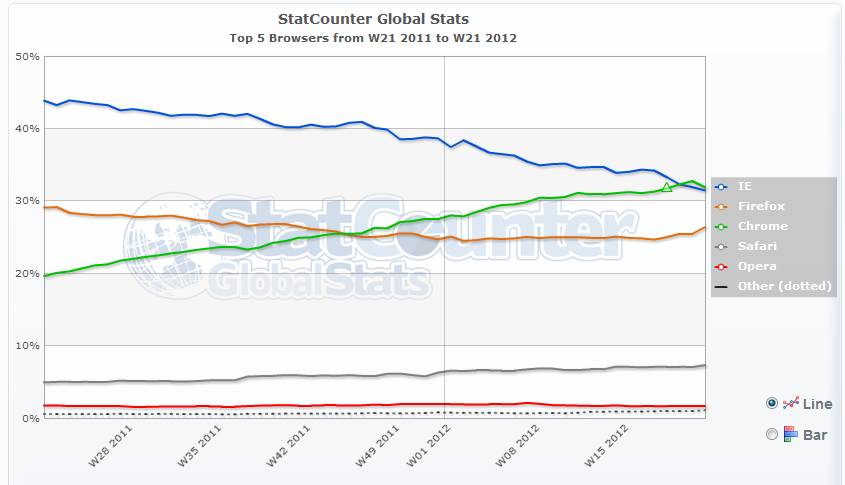Google's Chrome vs. Microsoft's IE: How's that halo effect?

Google's Chrome appears to be the most used browser as it passed Microsoft’s Internet Explorer, according to StatCounter. The larger question about the browser war revolves around whether there is a platform benefit to being top dog.
StatCounter's stats are based on a sample of 15 billion page views in the company's network. StatCounter’s browser usage data is notable, but I'd like to see a few others call the Chrome win before accepting the stats as gospel.
However, StatCounter’s data does give us an opportunity to zoom out a bit. Obviously, the browser wars mean something. Both Google and Microsoft are advertising their browsers---two pieces of software that are free.
A little more than a year ago, Google executives laid out their rationale for Chrome. It's worth noting what Google CFO Patrick Pichette said at that time.
There are really two stories on Chrome. There is a tactical question and there is a strategic question. Chrome is really pushing the Web, and it has a fantastic opportunity that, when people have adopted Chrome, they basically instead of looking for Google and looking for search, the omnibox gives them immediate access to Google search. So from a strategic perspective, it has that in Chrome OS. On a tactical basis, everybody that uses Chrome is a guaranteed locked-in user for us in terms of having access to Google.
Google's halo effect looks like this for Chrome:
- More search results.
- Lower traffic acquisition (TAC) costs.
- The ability to integrate Google's other services easily.
- A way to plug Google+ and integrate it into the browser.
- The lifetime value of a Google Chrome user is higher.
At a Bank of America Merrill Lynch conference May 8, Pichette elaborated. He said:
The core business continues to be healthy. It's a core focus of ours. But it's actually augments by a second set of priorities which is everybody knows the core platforms of Android, of Chrome, of YouTube, where you have the acceleration of an entire ecosystem which is both offensive by giving us these great platforms and also has a great defensive nature for the ecosystem to enable us to innovate. So, we continue to do that as well.
We have tools and means just like we did back then with the desktop to actually make sure that we manage our TAC so that in the desktop it was the same thing. We had toolbars and then we had Chrome. Chrome is a huge contributor to actually lowering TAC. It's not a static environment. It's a very dynamic environment. And mobile is nascent.
When a company's CFO is the biggest fan of Chrome it says something---there's real returns to be had.
Google clearly sees a monetary gain from Chrome. In a nutshell, the bigger Chrome gets the lower Google's TAC can be.
The Microsoft side of the ledger is similar, but the software giant hasn't pushed IE all that hard. Why? It has Windows.
Where Google sees its browser as a TAC saver, Microsoft positions IE as an extension of the OS.
Microsoft's halo effect looks like this:
- Traffic to Bing.
- Toolbars to drive usage to its other services.
- A say HTML and standards.
- A primary vehicle to highlight Windows 8 Metro apps.
- Ultimately integration with Office 365 and promoting Microsoft services.
Since Microsoft had its run-in with the Department of Justice, the company is much less in your face about IE market share.
After Chrome's gains, Microsoft started advertising IE more. But IE never gets the time on earnings conference calls that Chrome gets. Google has focused heavily on promoting Chrome. The results are just now showing up.
